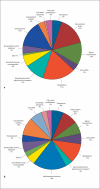Molecular and physiological responses to juvenile traumatic brain injury: focus on growth and metabolism
- PMID: 21071915
- PMCID: PMC3215243
- DOI: 10.1159/000320667
Molecular and physiological responses to juvenile traumatic brain injury: focus on growth and metabolism
Abstract
Traumatic brain injury (TBI), one of the most frequent causes of neurologic and neurobehavioral morbidity in the pediatric population, can result in lifelong challenges not only for patients, but also for their families. Survivors of a brain injury experienced during childhood - when the brain is undergoing a period of rapid development - frequently experience unique challenges as the consequences of their injuries are overlaid on normal developmental changes. Experimental studies have significantly advanced our understanding of the mechanisms and underlying molecular underpinnings of the injury response and recovery process following a TBI in the developing brain. In this paper, normal and TBI-related alterations in growth, development and metabolism are comprehensively reviewed in the postweanling/juvenile age range in the rat (postnatal days 21-60). As part of this review, TBI-related changes in gene expression are presented, with a focus on the injury-induced alterations related to cerebral growth and metabolism, and discussed in the context of existing literature related to physiological and behavioral responses to experimental TBI. Increasing evidence from the existing literature and from our own gene microarray data indicates that molecular responses related to growth, development and metabolism may play a particularly important role in the injury response and the recovery trajectory following developmental TBI. While gene expression analysis shows many of these changes occur at the level of transcription, a comprehensive review of other studies suggests that the control of metabolic substrates may preferentially be regulated through changes in transporters and enzymatic activity. The interrelation between cellular metabolism and activity-dependent neuroplasticity shows great promise as an area for future study for an optimal translation of experimental data to clinical TBI, with the ultimate goal of guiding therapeutic interventions.
Copyright © 2010 S. Karger AG, Basel.
Figures



References
-
- Giza CC, Mink RB, Madikians A. Pediatric traumatic brain injury: not just little adults. Curr Opin Crit Care. 2007;13:143–152. - PubMed
-
- Giza CC, Prins ML, Hovda DA, Herschman HR, Feldman JD. Genes preferentially induced by depolarization after concussive brain injury: effects of age and injury severity. J Neurotrauma. 2002;19:387–402. - PubMed
Publication types
MeSH terms
Grants and funding
LinkOut - more resources
Full Text Sources
Other Literature Sources
Research Materials

